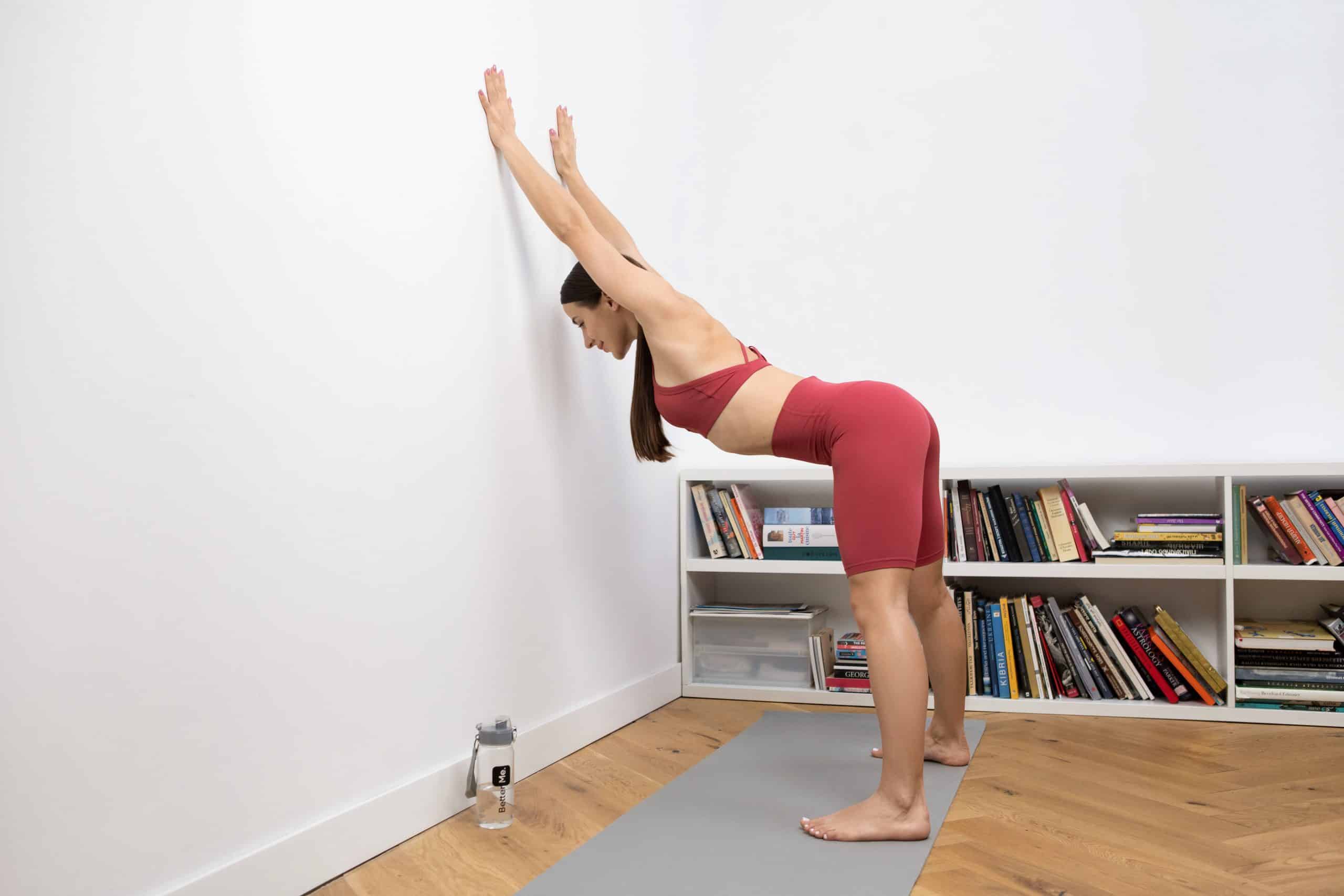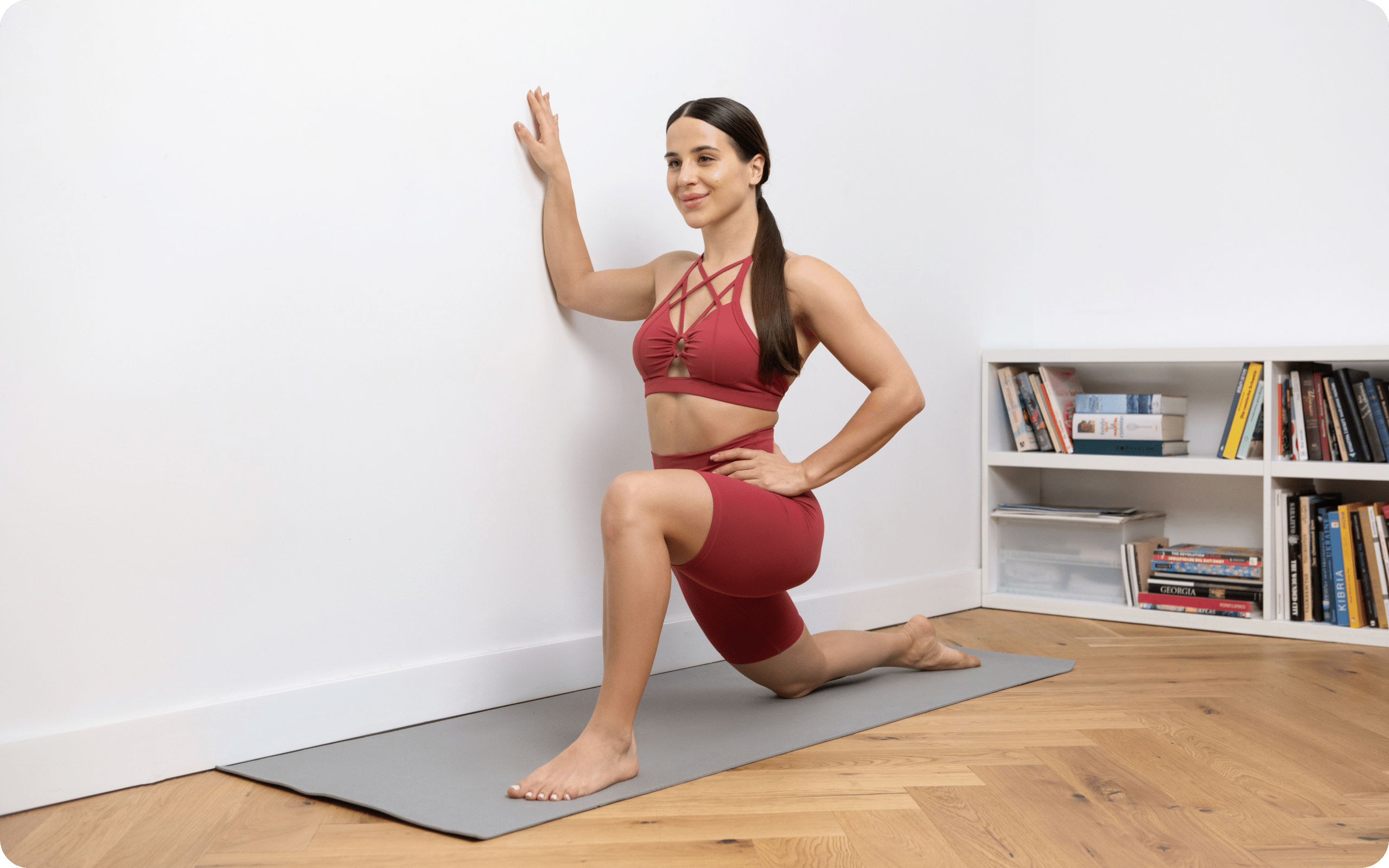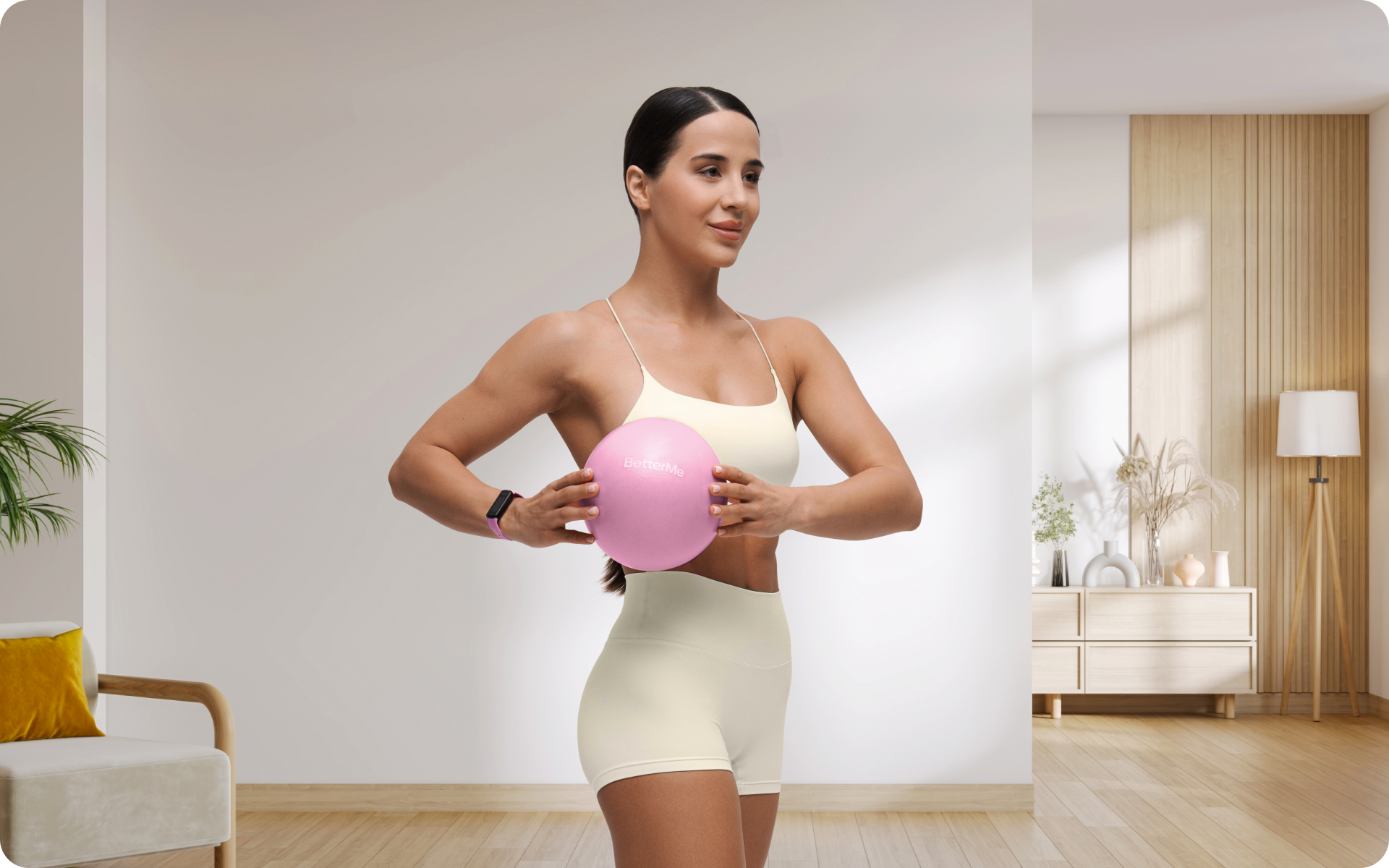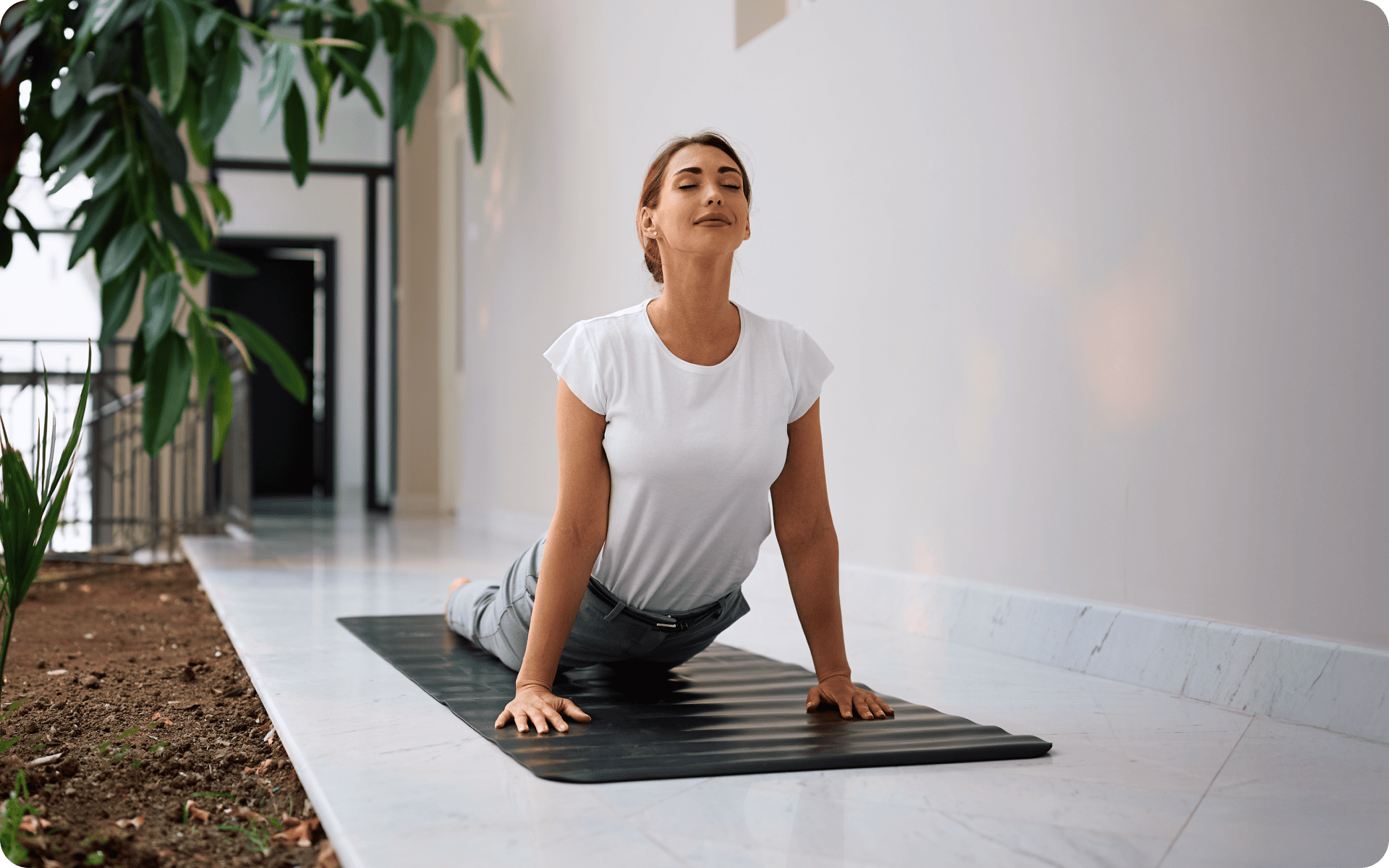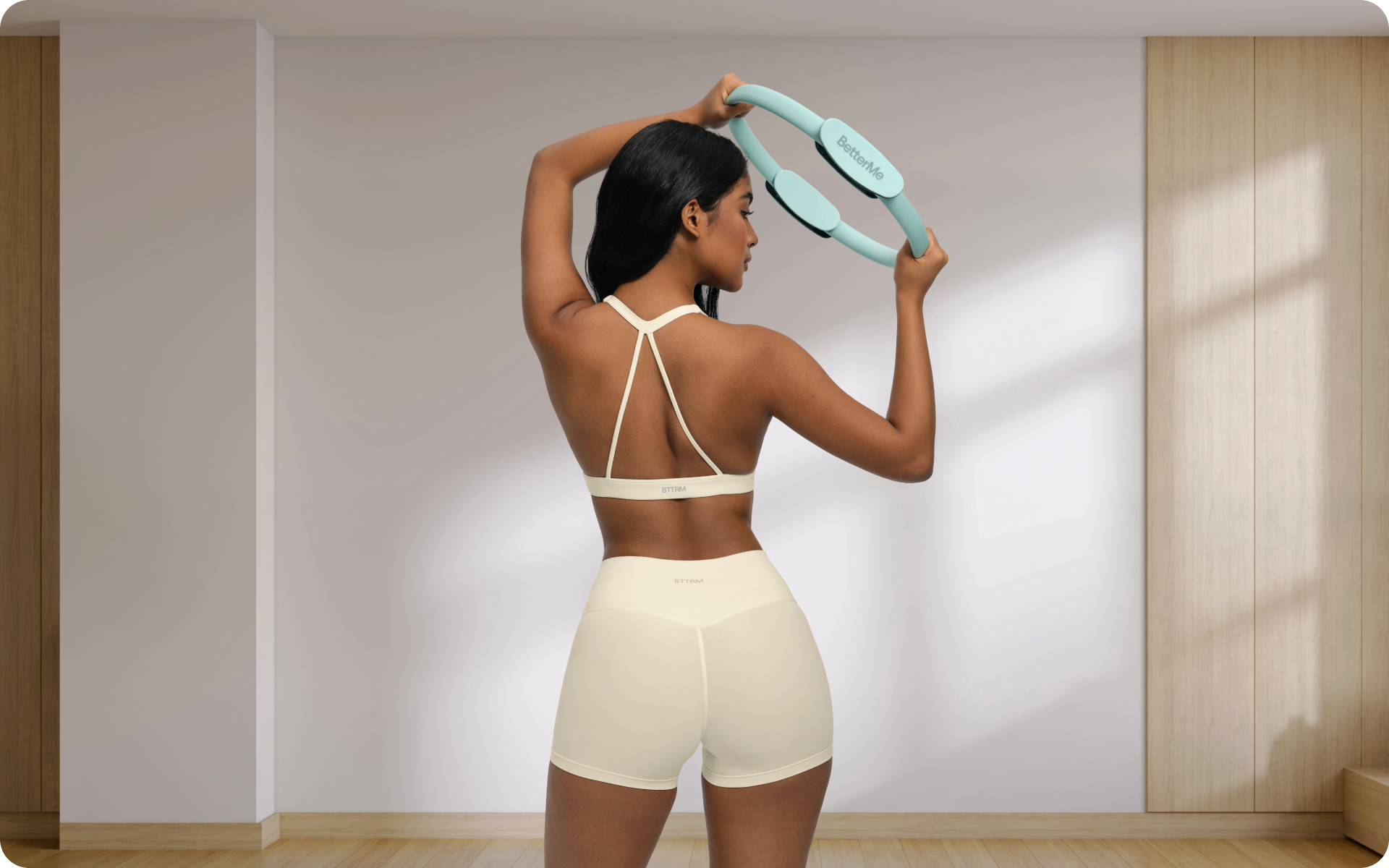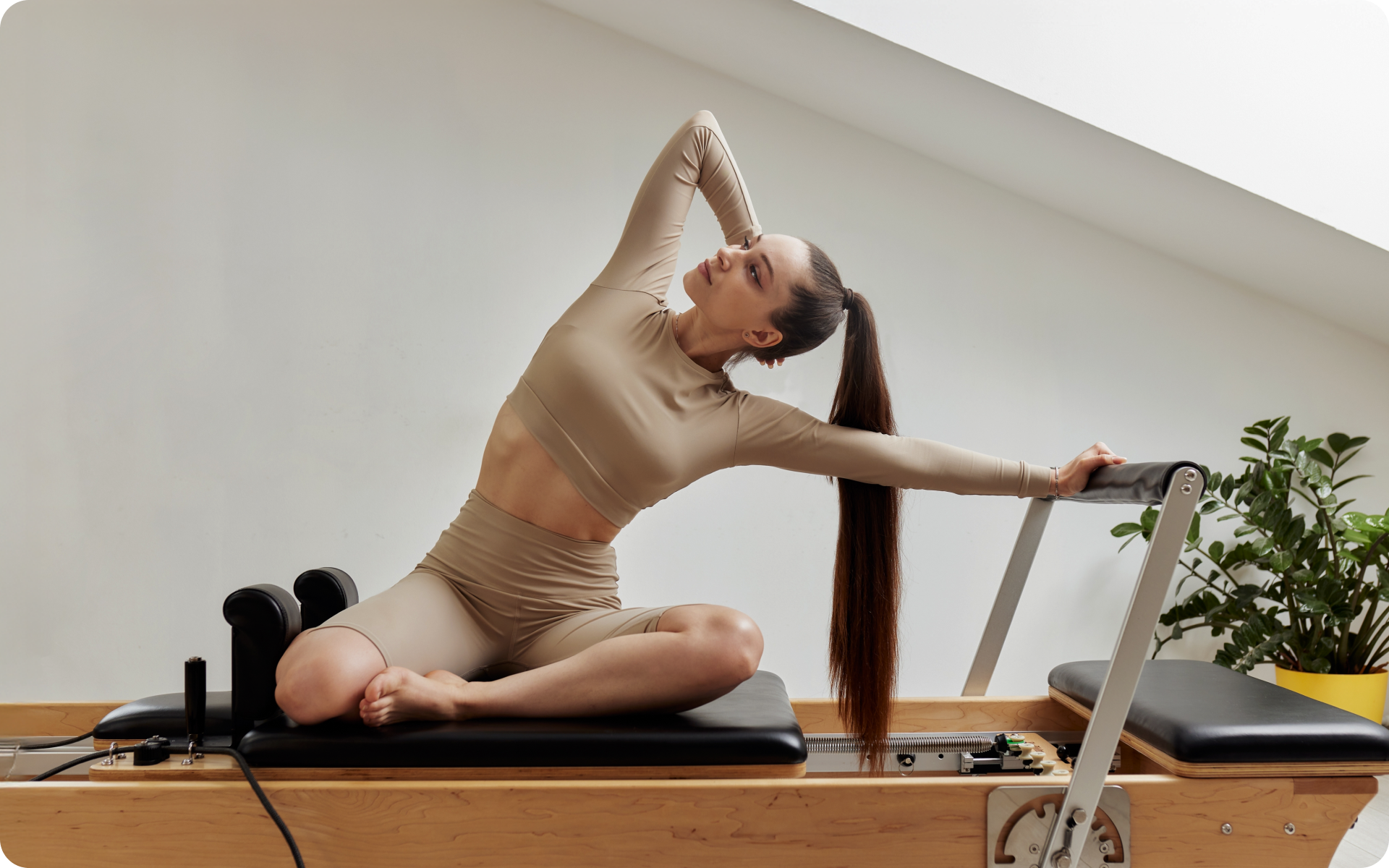What Is Wall Pilates?
Wall Pilates is a reformer-based Pilates workout that uses your body weight and the resistance of the wall to tone your muscles and improve your flexibility (3).
The movements are slow and controlled, which makes this workout perfect for those who are new to Pilates or are looking for a low-impact workout.
Plus, you won’t need to stress over the cost of a reformer or any other equipment and where to put it in your home – all you need is a wall!
Originally called “Contrology” by founder Joseph Pilates, Pilates has been practiced for over 90 years and has seen a recent resurgence in popularity. This whole body exercise is unique because it uses controlled, precise movements to tone your body, improve posture, and increase flexibility, while also strengthening your deep abdominal muscles. A traditional Pilates routine requires specialized equipment such as the Reformer, Wunda Chair or Cadillac, which can be found in most Pilates studios. This means that unless you have access to a studio or are willing to invest in some equipment, Pilates isn’t the most practical workout for at-home exercise. But there is a way to get a great Pilates workout without any equipment at all – by doing Wall Pilates!
Read on as we demystify, and give you a step-by-step guide to this excellent at-home Wall Pilates workout.
Is Wall Pilates Effective?
The role of the wall in Pilates is to provide support and stability for the beginner student. It helps ease the body into some of the more challenging positions and provides a feeling of security.
For people new to exercise, or those coming back from an injury, the wall can be a great way to get re-started with Pilates. Most importantly, the wall doubles up as a resistance training partner, providing extra resistance to help tone and sculpt your muscles.
When done correctly, Wall Pilates can be an extremely effective workout that offers the same benefits as a traditional Pilates workout:
Improves Core Strength
The human body was not designed to sit at a desk all day, yet most of us do. This can lead to weak core muscles and bad posture. Pilates is a great way to combat this by strengthening your deep abdominal muscles, which in turn will improve your posture (2).
Your core isn’t limited to your abdominal muscles; it also includes the muscles in your back and sides. The wall provides extra stability for your spine, which lets you focus on properly engaging your deep abdominal muscles – something that can be difficult for a beginner to do when doing Pilates on the mat.
Read More: 6 Pilates Principles You Must Know To Get Started
Improves Flexibility
Pilates’ popularity can be partially attributed to how flexible it makes you (3). Unlike most forms of exercise that focus on building muscle, Pilates lengthens your muscles, which gives you a longer, leaner look.
The wall can be used to help you deepen a stretch and improve your flexibility by providing support and stability.
Improves Muscular Endurance And Strength
Muscular endurance is an important quality to have (1), especially as we age. It’s the ability of your muscles to work for extended periods of time without tiring, and it’s essential for everyday activities such as carrying groceries or playing with your kids. Not only that—it translates to better performance in sports and other physical activities.
Wall Pilates is a great way to improve muscular endurance because the movements are slow and controlled. This forces your muscles to work for a sustained period of time, which leads to improved endurance (2). The wall also provides extra resistance, which strengthens your muscles.
Low Impact Exercise
The measure of how much force is exerted on your joints during an activity is known as the impact. High-impact activities, such as running or jump squats, can put a lot of wear and tear on your body, which can lead to joint pain or other injuries.
Low-impact activities, such as Pilates, don’t put as much strain on your body and are a great way to stay active without putting your joints at risk. Therefore, Pilates is an excellent choice for those with joint pain or other injuries that limit their mobility (2).
Can Aid Physical Rehabilitation
Pilates is often used in physical rehabilitation programs because of its low-impact nature and ability to improve core strength, flexibility, and muscular endurance (3). The wall can be used to provide support and stability for those who are recovering from an injury or surgery. It can also be a great way to ease your body into some of the more challenging positions.
Sample Full Body Pilates Wall Routine
Structuring your own Wall Pilates routine can be daunting, especially if you’re a beginner. Here’s a sample full-body routine that you can try. It’s inspired by the Full Body Wall Routine in the BetterMe App—an app that offers dozens of wall Pilates routines, as well as other fitness and nutrition programs;
- Time: 24 Minutes
- Calories Burned: 45
- Equipment Needed: Wall, Mat (optional)
Warm Up Set (6 Exercises 30 seconds – I minute each.)
Supported Roll Down (1 Minute)
- Stand tall against a wall. Walk your feet 6 inches away while your back stays flush against the wall.
- Brace your core. Keep your shoulders down and away from your ears.
- Inhale as you roll your spine down the wall, vertebra by vertebra. Feel your back muscles lengthening as you descend.
- Exhale as you reach the bottom of the roll. Keep your arms parallel to your sides.
- Hold for a breath or two. Inhale as you roll back up to the starting position.
- Repeat the roll down 5 more times.
Standing Hip Opener (0:45 seconds)
- Start standing next to the wall with one hand on the wall for support.
- Raise your outside leg so that your thigh is parallel to the floor. Keep your pelvis level and square to the front.
- Place your inside hand on your raised thigh for support.
- Gently press your raised leg into your hand as you exhale and open your leg out to the side.
- Hold for a breath or two. Inhale as you release your leg back to the starting position.
- Repeat on the other side.
Side Leg Swing (0:30seconds on each side)
- Start standing next to the wall with one hand on the wall for support.
- Raise your outside leg so that your thigh is parallel to the floor. Keep your pelvis level and square to the front.
- Swing your leg out to the side and up as high as you can while keeping your pelvis level.
- Reverse the motion, swinging your leg back to the starting position.
- Repeat on the other side.
Active Calf Stretch (0:45 on each side)
- Start standing next to the wall with your palms flat against the wall at shoulder height.
- Step your left leg back about 2 feet and keep your heel flat on the floor.
- Keeping your left leg straight, bend your right knee and lean into the wall until you feel a stretch in your left calf.
- Hold for a breath or two. Release and repeat on the other side.
Keep your body sculpted with the game-changing fitness app. Start transforming your body with BetterMe.
Main Set (2 Circuits of 8 Exercises, 0:45 seconds each)
Supported Semi Lunge
- Start standing next to the wall with one hand on the wall for support.
- Step your left leg back about 2 feet and press your left palm flat against the wall.
- Keeping your heel down, bend your right knee and lean your torso forward until you feel a stretch in your left hamstring.
- Hold for a breath or two. Release and repeat on the other side.
Standing Knee Raise
- Start standing next to the wall with one hand on the wall for support.
- Brace your core and raise your right knee up towards your chest.
- As you raise your knee, press your lower back into the wall.
- Hold for a breath or two. Release and repeat on the other side.
Wall DB Arm Raise
- Stand against the wall with a light dumbbell in each hand and your elbows bent at 90 degrees.
- Brace your core and slowly raise your arms up until they are parallel to the floor.
- Hold for a breath or two and then lower your arms back to the starting position.
Walls DB Arm Circles
- Stand against the wall with a light dumbbell in each hand and your elbows bent at 90 degrees.
- Brace your core and slowly raise your arms up until they are parallel to the floor.
- From here, trace small circles in the air for 30 seconds.
- Reverse the direction of the circles and continue for another 30 seconds.
Chest Openers
- Stand with your back against the wall and your feet about 2 feet away from the wall.
- Place your palms flat against the wall at shoulder height.
- Brace your core and press your chest into the wall as you slide your hands up the wall until your arms are fully extended overhead.
- Hold for a breath or two and then release back to the starting position.
Wall Sits
- Stand with your back against the wall and your feet about 2 feet away from the wall.
- Slowly slide down the wall until your thighs are parallel to the floor.
- Hold this position for 30 seconds or as long as you can.
Read More: Pilates For Posture: How It Works And The Best Exercises To Do
Cool Down (0:45 seconds each)
Seated Opposite Toe Tap
- Start seated on the floor with your back against the wall and legs straight out in front of you.
- Spread your legs out so that they are about hip-width apart.
- Brace your core and press your lower back into the wall.
- From here, reach out and tap your right toes with your left hand.
- Alternate sides for 45 seconds or as long as you can.
Seated Spine Twist
- Start seated on the floor with your back against the wall and legs straight out in front of you.
- Spread your legs out so that they are about hip-width apart.
- Brace your core
- From here, twist your torso to the right and reach your left hand out to touch the ground outside of your right leg.
- Reverse the twist and reach your right hand out to touch the ground outside of your left leg.
- Alternate sides for 45 seconds or as long as you can.
Butterfly Stretch
- Sit on the ground with your back against the wall and your legs bent in front of you, soles of the feet touching.
- Let your knees fall open to the sides and press your low back into the wall.
- From here, reach your arms out overhead and arch your back away from the wall.
- Hold for a breath or two and release back to the starting position.
Seated Forward Fold
- Sit on the ground with your back against the wall and your legs bent in front of you, soles of the feet touching.
- Let your knees fall open to the sides and press your low back into the wall.
- From here, reach your arms out overhead and fold forward from the hips, letting your head and shoulders hang heavy.
- Hold for a breath or two and release back to the starting position.
FAQs
Is wall Pilates actually effective?
Yes, wall Pilates is effective in more ways than one. It’s similar to floor Pilates, but the addition of the wall provides extra support and stability, which allows for a deeper and more controlled workout. The wall also helps improve posture and balance, making wall Pilates an effective exercise for people with back pain or postural issues.
Is the 28-day wall Pilates challenge free?
There are different options for a 28-day wall Pilates challenge both paid and free. A paid challenge, particularly one with a certified instructor, can provide valuable guidance and modifications that are tailored to your specific needs and goals.
The BetterMe Wall Pilates Challenge is a popular and highly-rated option for those who are looking to try wall Pilates for the first time.
Is 20 minutes of Pilates a day enough?
20 minutes of Pilates a day can be enough if the exercises are performed correctly and with proper form, if it’s focused on engaging the core muscles, and if it incorporates a variety of movements and modifications.
Proper form will ensure the exercises target the intended muscles and prevent injury.
Engaging the core muscles, or the powerhouse, is also essential with Pilates as it creates a strong foundation for movements and helps you develop a leaner, more toned body.
Finally, incorporating modifications and variety into your workout will help challenge your body and you will continue seeing progress
Final Thoughts
Wall Pilates is a great way to work on your posture and alignment, as well as strengthen your core and other key muscle groups. Use this guide as a starting point to get the most out of your Wall Pilates practice. Remember to listen to your body and only do what feels comfortable for you.
DISCLAIMER:
This article is intended for general informational purposes only and does not serve to address individual circumstances. It is not a substitute for professional advice or help and should not be relied on for making any kind of decision-making. Any action taken as a direct or indirect result of the information in this article is entirely at your own risk and is your sole responsibility.
BetterMe, its content staff, and its medical advisors accept no responsibility for inaccuracies, errors, misstatements, inconsistencies, or omissions and specifically disclaim any liability, loss or risk, personal, professional or otherwise, which may be incurred as a consequence, directly or indirectly, of the use and/or application of any content.
You should always seek the advice of your physician or other qualified health provider with any questions you may have regarding a medical condition or your specific situation. Never disregard professional medical advice or delay seeking it because of BetterMe content. If you suspect or think you may have a medical emergency, call your doctor.
SOURCES:
- Musculoskeletal fitness, health outcomes and quality of life (2001, nih.gov)
- Pilates – health benefits (2022, betterhealth.vic.gov.au)
- Pilates: how does it work and who needs it? (2011, nih.gov)
